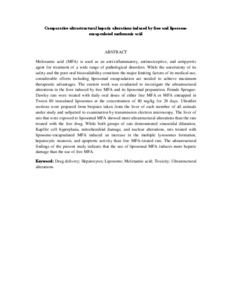Citation
Jarrar, Qais Bashir Mahmoud and Abdullah, Muhammad Nazrul Hakim and Cheema, Manraj Singh and Zakaria, Zainul Amiruddin
(2017)
Comparative ultrastructural hepatic alterations induced by free and liposome-encapsulated mefenamic acid.
Ultrastructural Pathology, 41 (5).
pp. 335-345.
ISSN 0191-3123; ESSN: 1521-0758
Abstract
Mefenamic acid (MFA) is used as an anti-inflammatory, antinociceptive, and antipyretic agent for treatment of a wide range of pathological disorders. While the uncertainty of its safety and the poor oral bioavailability constitute the major limiting factors of its medical use, considerable efforts including liposomal encapsulation are needed to achieve maximum therapeutic advantages. The current work was conducted to investigate the ultrastructural alterations in the liver induced by free MFA and its liposomal preparation. Female Sprague-Dawley rats were treated with daily oral doses of either free MFA or MFA entrapped in Tween 80 inoculated liposomes at the concentration of 80 mg/kg for 28 days. Ultrathin sections were prepared from biopsies taken from the liver of each member of all animals under study and subjected to examination by transmission electron microscopy. The liver of rats that were exposed to liposomal MFA showed more ultrastructural alterations than the rats treated with the free drug. While both groups of rats demonstrated sinusoidal dilatation, Kupffer cell hyperplasia, mitochondrial damage, and nuclear alterations, rats treated with liposome-encapsulated MFA induced an increase in the multiple lysosomes formation, hepatocytic steatosis, and apoptotic activity than free MFA-treated rats. The ultrastructural findings of the present study indicate that the use of liposomal MFA induces more hepatic damage than the use of free MFA.
Download File
![[img]](http://psasir.upm.edu.my/59393/1.hassmallThumbnailVersion/Comparative%20ultrastructural%20hepatic%20alterations%20induced%20by%20free%20and%20liposome-encapsulated%20mefenamic%20acid.pdf)  Preview |
|
Text (Abstract)
Comparative ultrastructural hepatic alterations induced by free and liposome-encapsulated mefenamic acid.pdf
Download (35kB)
| Preview
|
|
Additional Metadata
Actions (login required)
 |
View Item |

